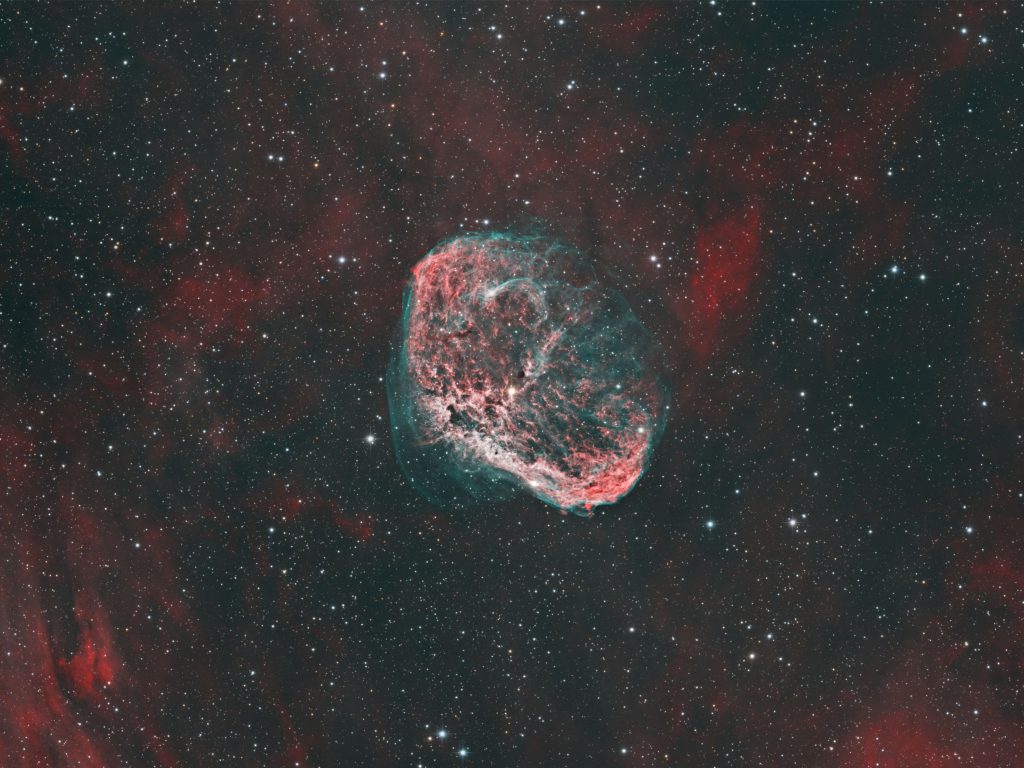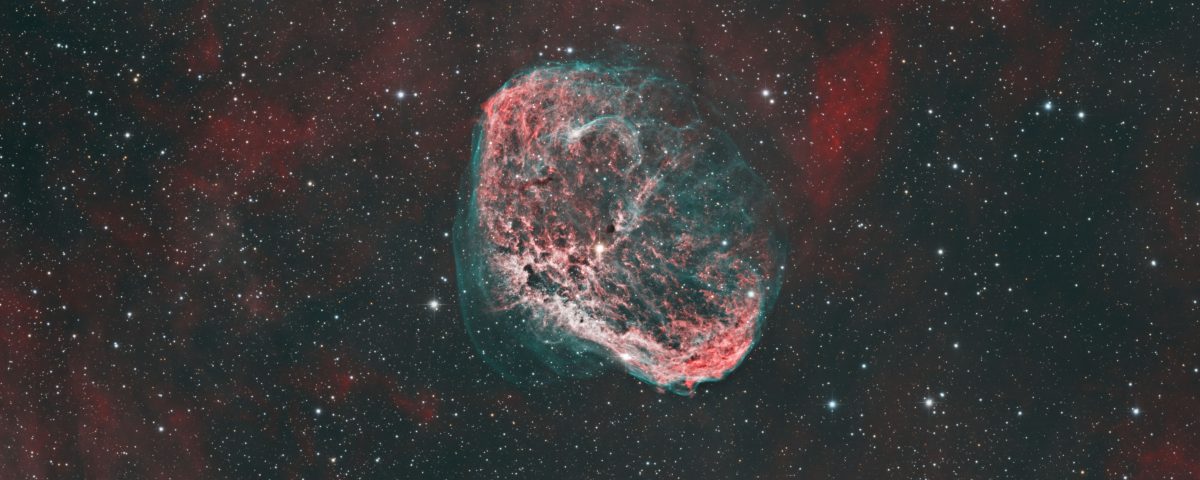Nebuloasa Semilună de Bogdan Stanciu

Soarele explorat cu luneta solară LUNT 50/350 LS50THa/B600PT al Astroclubului București de Răzvan Orbu
octombrie 27, 2025
Nebuloasa Leului (Sharpless 2-132) de Bogdan Stanciu
noiembrie 2, 2025Data publicării: 2 noiembrie 2025
RO (for English scroll down)
NGC 6888 poartă porecla de „Nebuloasa Semilună” datorită aspectului său atunci când este observată printr-un telescop. Unii astronomi cred că seamănă cu o meduză uriașă, însă acest nume fusese deja atribuit obiectului IC 443. William Herschel a descoperit acest obiect în anul 1792, însă a observat doar marginea nord-vestică, mai strălucitoare.
NGC 6888 este o nebuloasă tipică formată de vânturi stelare, asociată cu o stea Wolf-Rayet de magnitudine +7,5, WR 136, situată în arcul nord-vestic al nebuloasei. „Semiluna” reprezintă o bulă circumstelară formată prin coliziunea dintre vântul stelar emis de WR 136 și materialul expulzat în timpul fazei sale anterioare de supergigantă roșie. Mai exact, nebuloasa este o bulă fotoionizată înconjurată de un inel de emisie încălzit de șocuri, alimentat de presiunea internă a bulei create de vântul stelar.
Situată la peste 5.000 de ani-lumină distanță, nebuloasa are o dimensiune reală de aproximativ 12 x 9 ani-lumină. Viteza de expansiune variază între 55 și 110 km/s, ceea ce indică o vârstă de aproximativ 2 milioane de ani. Observațiile spectroscopice ale bulei arată că aceasta este bogată în azot și heliu, dar săracă în oxigen.
Observațiile în infraroșu efectuate cu sonda IRAS au dezvăluit o structură exterioară cu o masă echivalentă cu 8.000 de sori și un diametru de 60 de ani-lumină, formată în timpul fazei de supergigantă roșie a stelei WR 136. Observațiile în lumina O III arată că vântul stelar a străpuns marginea nordică mai strălucitoare, creând un front de șoc exterior. Vântul stelar încălzește mediul interstelar până la temperaturi de raze X – existând o componentă de temperatură ridicată (8,5 milioane K) și una de temperatură scăzută (1,3 milioane K), ambele foarte prezente în acest strat extern.
WR 136 este de tip WN6, ceea ce înseamnă că spectrul său prezintă linii proeminente de heliu și azot. Stelele Wolf-Rayet sunt descendenții stelelor masive de tip OB (cu mase mai mari de 25 de mase solare) și, prin urmare, sunt destinate să explodeze ca supernove. Înainte de asta, pierderea de masă a stelei (aproximativ o masă solară la fiecare 10.000 de ani) joacă un rol crucial în modelarea mediului din jur.
Pentru a explica nebuloasa și structurile din jur, a fost propus modelul celor „trei vânturi”. Primul vânt provine de la stea în timpul perioadei sale de secvență principală. Acest vânt rarefiat, de mare viteză (2.000 km/s), mătură mediul interstelar, formând o bulă de vânt stelar de secvență principală. Când steaua devine o supergigantă roșie, vântul încetinește (10 km/s) și devine dens, extinzându-se în interiorul rarefiat al bulei anterioare. În cele din urmă, un vânt rapid emis de steaua Wolf-Rayet sparge bula supergigantei roșii, formând structura observată astăzi.
Expunere totală: 8h HOO (narrowband)
Telescop: PlaneWave CDK 14” f/7,2 – MOANA Project
Camera: ASI 1600MM
Procesare: PixInsight
Autor text și foto: Bogdan Stanciu
EN
NGC 6888 goes by the nickname Crescent Nebula due to its appearance as seen in a telescope. Some other astronomers think it looks like a giant jellyfish, but this name was already taken by IC 443. William Herschel discovered this object in 1792, but he only noticed the brighter NW rim.
NGC 6888 is a prototypical wind-blown nebula, associated with a +7.5 magnitude Wolf-Rayet star, WR 136, located in the NW arc of the nebula. The “crescent” is a circumstellar shell formed by the collision of the stellar wind issuing from WR 136 with material shed during its preceding red supergiant phase. More specifically, yhe nebula is a photoionized shell enveloped in a shock-heated ring of emission powered by the internal pressure of the wind-blown bubble.
Located more than 5.000 light-years away, the true size of the nebula is 12 x 9 light-years. The expansion velocity ranges between 55 and 110 km/s, yielding an age of about 2 million years. Spectroscopic observations of the nebular shell show that it’s rich in nitrogen and helium and poor in oxygen.
Infrared observations with the IRAS probe revealed an outer shell with a mass of 8.000 suns and 60 light-years across. This was created during WR 136’s red supergiant phase. O III observations show that the wind has punctured through the brighter northern rim, creating an outer shock front. The stellar wind heats the interstellar medium up to X-ray temperatures – there is a high temperature component (8,5 million K) and a low temperature component (1,3 milllion K), both highly represented in the nebular shell.
WR 136 is a WN6 type, meaning its spectrum exhibits prominent lines of helium and nitrogen. WR stars are descendants of massive OB stars (>25 solar masses) and as such they are fated to go supernovae. Before that happens, the star’s mass loss (1 solar mass every 10.000 years) plays a huge role in shaping its surroundings. The 3-wind model is proposed to explain the nebula and the surrounding structures. The first wind originates from the star while it’s still on the main sequence. This rarefied, high-velocity wind (2.000 km/s) sweeps up the interstellar medium, forming a main-sequence stellar wind bubble. When the star becomes a red supergiant, the wind slows down (10 km/s) and becomes dense, expanding into the rarefied interior of the previous bubble. Finally, a fast wind from the WR star breaks up the red supergiant bubble, forming the observed bubble.
Exposure time: 8h HOO (narrowband)
Telescope: PlaneWave CDK 14” f/7,2 – MOANA Project
Camera: ASI 1600MM
Processing: PixInsight
Author text and photo: Bogdan Stanciu




